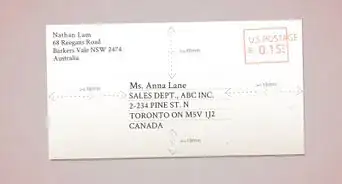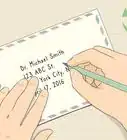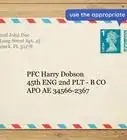This article was co-authored by Tami Claytor. Tami Claytor is an Etiquette Coach, Image Consultant, and the Owner of Always Appropriate Image and Etiquette Consulting in New York, New York. With over 20 years of experience, Tami specializes in teaching etiquette classes to individuals, students, companies, and community organizations. Tami has spent decades studying cultures through her extensive travels across five continents and has created cultural diversity workshops to promote social justice and cross-cultural awareness. She holds a BA in Economics with a concentration in International Relations from Clark University. Tami studied at the Ophelia DeVore School of Charm and the Fashion Institute of Technology, where she earned her Image Consultant Certification.
This article has been viewed 267,895 times.
When posting a letter, you want to make sure you address the envelope correctly in order to help your letter get delivered to the correct place on time. Many countries have specific requirements for addressing an envelope correctly, including Great Britain. Great Britain is a term that describes the combination of England, Scotland, and Wales, the three nations which together include all the land on the island. Knowing how to send an envelope with the required elements of an address in Great Britain will help you look professional and ensure that your mail gets to its destination properly.
Steps
Mailing an Envelope within Great Britain
-
1Position the address correctly. Some countries have varying conventions on where to write the address on an envelope. In Great Britain, the address is positioned in the bottom left corner on the front of the envelope. When positioning the first line, be sure to plan ahead so that you leave enough room for the next lines of text. You should also plan to leave a generous margin of about 1/2 an inch (1.3 cm) around the entire address.[1]
-
2Left align all address elements. As you begin to write the address out on the envelope, be sure to left align all of the text in each line. Some countries prefer that the address is centered, both in placement on the envelope and the alignment of the text, but in Great Britain the correct format is for all of the address lines to be aligned against the left address margin.[2]Advertisement
-
3Write clearly using good penmanship and permanent ink. In order for the envelope to be processed properly, you want to make sure that the mail carrier can read the address clearly. If you are handwriting the address, use a pen or ink that is clear against the color of the envelope. Do not use pencil or anything that could be easily smudged or rubbed off during the journey. If you are printing an address label, be sure to use a font that is easy to read and a color that stands out against the label. For both handwritten and printed addresses, make to size the text so it can be ready easily, with a text size comparable to a font size of 10 - 15.
-
4Write the name of the recipient on the first line. Be sure to include their first name and surname, spelling each correctly. For close friends and family members it is a personal preference whether you include titles with the name; however, for any other recipient you should specify titles (e.g., Mr., Mrs., Ms., Miss, Dr., etc.). If you are sending the envelope to a person at a specific organization, you should include the name of the organization in a separate line underneath their name.[3]
-
5On the next line write the property number and street name. If the place you are mailing the envelope to has an official building number or property name, like “Building J49” or “Victoria House,” include this underneath the recipient's name and drop the property number and street name to the next line. If the property does not have a full name, simply include the property number and the name of the street, or “thoroughfare” as it's called in Great Britain.[4]
-
6Include locality information on the next line(s). There are three types of localities in Great Britain, and in order for mail to get sorted properly the post town has to be included. There are two other locality elements that you can include as well, but only the post town is required. Each element needs to be included on separate lines. Each locality should be written in normal letter case, except for the post town, which should be all uppercase letters. You do not need to include the county name. For example:[5]
- Locality line 1 is the double dependent locality (i.e., the neighborhood or borough): Otterley
- Locality line 2 is the dependent locality (i.e., the town or civil parish): Hedge End
- Locality line 3 (or line 1 since it is the only one required) is the post town (i.e., the county town): OXFORD
-
7Write the postcode on the last line. The postcode aids in the sorting and delivery of mail and is similar to zip code in the United States. Like the post town, the postcode should be written in all capital letters. You should also include two spaces between the two parts of the post code (e.g., BH1 1AA). Since you are sending the envelope from a Great Britain address to a recipient in Great Britain, you should not include a destination country. The postcode should be the final line in the address..
- If you don't know the postcode, you can look it up on the Royal Mail website: http://www.royalmail.com/find-a-postcode
-
8Include a return address. A return address is an address that the post office uses to send the mail back to in case there is a reason the envelope could not be delivered. Even if you include all the elements of the address correctly, it is still a good idea to always include a return address when you mail something. In Great Britain, the return address is written on the back of the envelope (the side with the flap) in a center position with the text left aligned. You need to include all of the same elements as the front address, except the first line here should read “Return Address” with all the other lines coming after that.[6]
-
9Include the appropriate postage. Postage is always required to send any envelope in the mail. The appropriate amount of postage depends on the size and weight of the envelope or parcel you are sending, with larger, heavier packages costing more money. The postage should always be included on the front of the envelope in the top right corner so that the mail carrier can read the address and confirm the shipping was paid for at the same time.
- If you are not sure how much postage you need, you can look it up on the Royal Mail website: http://www.royalmail.com/personal/uk-delivery/stamps
Mailing an Envelope Outside of Great Britain (International Mail)
-
1Position the address correctly on the envelope. Since you are sending an envelope from Great Britain to an international recipient, you should still position the address per Great Britain's requirements. This means that the address should be positioned in the bottom left corner on the front of the envelope. When positioning the first line, be sure to plan ahead so that you leave enough room for the several lines of text, including a line for the country. You should also plan to leave a margin of about 1/2 an inch (1.3 cm) around the entire address.[7]
-
2Left align all address elements. While some countries prefer that the address is centered, both in placement on the envelope and the alignment of the text, you still want to stick with Great Britain's conventions for formatting. In Great Britain the correct format is for all of the address lines to be aligned against the left address margin.
-
3Use good penmanship and indelible ink. International mail has a long journey, so you want to make sure the address remains clear in order for it to be processed properly. When handwriting the address, use a pen with permanent ink in a color that is clear against the color of the envelope. Do not use pencil or anything that could be easily smudged or rubbed off during processing. If you are printing an address label, choose a font that is easy to read and use a color that stands out against the label. For both handwritten and printed addresses, size the text so it can be ready easily, with a text size comparable to a font size of 10 - 15.
-
4Write the name of the recipient on the first line. Be sure to include their first name and surname, spelling each correctly. Because it is international mail you should include a title with the name even for close friends and family members. If you are sending the envelope to a person at a specific organization, you should include the name of the organization in a separate line underneath their name. Some country-specific things to remember when writing out the name:[8]
- Remember some countries use alternative titles (e.g., Herr or M. vs. Mr., Sra or Mme vs. Mrs., Mlle vs. Miss, etc.).
- When addressing mail to France or Monaco, write the recipient's surname in CAPITAL letters (e.g., M. Robert MARIN).
-
5On the next line write the property number and street name. If the place you are mailing the envelope to has an official building number or property name, like “U.S. Embassy” or “Paris-Sorbonne University,” include this underneath the recipient's name and drop the street name and property number to the next line. If the property does not have a full name, simply include the property number and the name of the street. Keep the following in mind when writing the street address for other countries:[9]
- For most countries outside of the United States, Canada, UK, Australia, and New Zealand, the house number is written after the street name (e.g., “Rue du Diamant 215” instead of “215 Rue du Diamant).
- If you don't know the correct order for the country you are sending the envelope to, you can look it up on the Royal Mail website: https://www.royalmail.com/sending/international/country-guides
-
6Include the name of the locality and the postcode on the next line(s). There are three types of localities: the double dependent locality, the dependent locality, and the post town. For most international mail, the address is only required to have the post town and postcode included, this time on the same line. If you need or want to include other locality elements, such as the state or province, they should go above the post town and postcode line, which should always be the second to last line for international mail. The post town and any letters in the postcode (if applicable) should all be written in capital letters, with other locality information written in normal case. Keep the following in mind when writing these elements for other countries:[10]
- Some countries like Germany require the postcode to come before the post town.
- Countries like Portugal require the province to be included in brackets after the post town.
- Australia and the United States require the state abbreviation to be inserted between the post town and postcode.
- For a full list of country-specific requirements for post towns and postcodes, look it up on the Royal Mail website: https://www.royalmail.com/sending/international/country-guides
-
7Write the country name as the last line. As a requirement for international mail, the destination country must be included on the last line of the address. For all countries, this must be written in in capital letters. This line should not contain any other information and needs to be spelled correctly. Do not abbreviate the country. For example, write out “UNITED STATES OF AMERICA” instead of “U.S.” or “USA.”[11]
-
8Include a return address. In case the envelope needs to be sent back to you, a return address should be included with all international mail. It is not a requirement, but international mail is complicated, and sometimes mail is returned even if you include all of the address elements correctly. Since you are sending the mail from Great Britain, follow the convention of including the return address on the back of the envelope (the side with the flap). Position the return address in the center of the envelope with the text left aligned. You need to include all of the same elements as the front address, except the first line here should read “Return Address.” Be sure to also include your country in all capital letters as the last line in the return address.
-
9Include the appropriate postage. Postage is always required to send any envelope in the mail, but there are sometimes special requirements for sending international mail, like customs labels. The appropriate amount of postage depends on the size and weight of the envelope or parcel you are sending, with larger, heavier packages costing more money. Include the postage on the front of the envelope in the top right corner so that the mail carrier can read the address and confirm the shipping was paid for at the same time.
- If you are not sure how much postage you need for international mail, or you want to check if a customs label is needed, look it up on the Royal Mail website: http://www.royalmail.com/personal/uk-delivery/stamps
References
- ↑ http://www.royalmail.com/personal/help-and-support/How-do-I-address-my-mail-correctly
- ↑ https://personal.help.royalmail.com/app/answers/detail/a_id/81/~/how-to-address-your-mail-%28clear-addressing%29
- ↑ http://www.royalmail.com/personal/help-and-support/How-do-I-address-my-mail-correctly
- ↑ https://www.postoffice.co.uk/mail/how-to-address-mail
- ↑ https://www.postoffice.co.uk/mail/how-to-address-mail
- ↑ https://personal.help.royalmail.com/app/answers/detail/a_id/81/~/how-to-address-your-mail-%28clear-addressing%29
- ↑ http://www.royalmail.com/personal/help-and-support/How-do-I-address-my-mail-correctly
- ↑ https://www.postoffice.co.uk/mail/how-to-address-mail
- ↑ https://www.postoffice.co.uk/mail/how-to-address-mail
About This Article
To put an address on an envelope in Britain, start by writing it in the bottom left-hand corner of the envelope, but leave enough space so there is a 1/5 inch border around the address. Make sure all address lines are left aligned as you write them in permanent ink. On the first line, include the person's full name, then add the property name or number on the second line. When you're on the third line, include the local town or area. Finally, write the post code on the last line, which is used to help sort out mail. To find out where to write a return address and what the appropriate postage is, read on!
-Step-1-Version-3.webp)
-Step-2-Version-3.webp)
-Step-3-Version-3.webp)
-Step-4-Version-3.webp)
-Step-5-Version-3.webp)
-Step-6-Version-3.webp)
-Step-7-Version-3.webp)
-Step-8-Version-3.webp)
-Step-9-Version-3.webp)
-Step-10-Version-3.webp)
-Step-11-Version-3.webp)
-Step-12-Version-3.webp)
-Step-13-Version-3.webp)
-Step-14-Version-3.webp)
-Step-15-Version-3.webp)
-Step-16-Version-3.webp)
-Step-17-Version-3.webp)
-Step-18-Version-3.webp)





























































